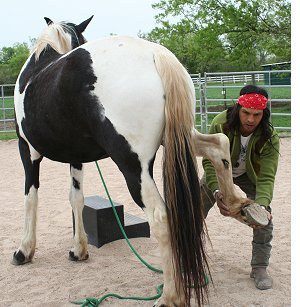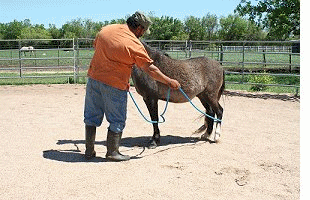 Picking up your horse’s feet can present a challenge, but it is necessary. Some horses refuse to lift the foot. Some grab it from you and stamp it to the ground. Some put all of their weight on it when you are holding it. Some kick when you try to get close. Some kick out behind. It can be a dangerous job if not properly taught.
Picking up your horse’s feet can present a challenge, but it is necessary. Some horses refuse to lift the foot. Some grab it from you and stamp it to the ground. Some put all of their weight on it when you are holding it. Some kick when you try to get close. Some kick out behind. It can be a dangerous job if not properly taught.
Some things to consider when holding a horse’s foot” It requires that he stand on 3 legs. That alone might be uncomfortable or he may be slightly uncoordinated at first.
If you “keep” that foot, he experiences a “fight or flight” reaction. Having his feet held takes away his “flight” option and might bring out his “fight”.
In the early stages, remember “baby steps” will accomplish the goal. Break it down into small parts.
 Start by tossing and curling the rope around each leg from top to bottom. Let it wrap firmly around the pasterns and fetlocks, and don’t stop until the horse stands still, relaxes and is no longer dancing around when his legs are momentarily “tied together” with the curling rope. Depending on how long your horse has been objecting to foot manipulation, this might take 5 minutes or 5 days.
Start by tossing and curling the rope around each leg from top to bottom. Let it wrap firmly around the pasterns and fetlocks, and don’t stop until the horse stands still, relaxes and is no longer dancing around when his legs are momentarily “tied together” with the curling rope. Depending on how long your horse has been objecting to foot manipulation, this might take 5 minutes or 5 days.
Now make sure you can rub the leg all the way down to the hoof. Rub up and down. If you have trouble with this, see De-Sensitizing, and go back to the rope.
I do not recommend that this be taught with a horse tied up (even though I am doing it with the yearling at the end of the video). A tied horse can get seriously panicked if he senses that he is restricted or cornered. Just take him to the round pen. Let the lead dangle. If necessary, get a partner to hold his front while you work with him. Don’t expect your partner to keep him totally under control – just try to soothe, calm, and keep him from actually running off. If he is seriously unmanageable, even with a partner, he is not ready for this exercise.
Front Feet
Assuming you have already done the rope de-sensitizing and leg wrapping. Start with the front legs. Ask the horse to pick up the foot by twisting on the little acorn up near the knee. This is a little like a pinch. It is uncomfortable enough that he would like you to quit doing it. His first reaction is to pull the leg away, and in so doing, he lifts the foot. As soon as he lifts for even a fraction of a second, stop twisting or pulling. (a baby step toward compliance). Alternately, you can grab the pastern or the hair behind the hoof. (The acorn is the easiest because it induces them to pick the foot up FOR you instead of you lifting it yourself.)
Ask again. Reward again by releasing the pressure the moment the foot leaves the ground. Now massage the whole leg again before you repeat the exercise. Ask again. Reward again. Repeat this until the horse instantly lifts the foot when you touch the acorn.
Once you have succeeded in getting a lift, start asking for a longer hold. Prolong this until you can get your hand under the hoof and hold for a second, then two seconds, then three.
Gradually build on the little successes. Try to anticipate his tolerance. If you think he can tolerate only 5 seconds before jerking his foot away from you, put it down in 4 seconds. Work until he allows you to cradle his hoof for many seconds. Of course, he may occasionally grab the foot out of your hands and stamp it down. If that happens, immediately pick it up again and then put it back down quickly, but don’t allow him to stand there after the jerk so that he thinks he has won.
If he tries to struggle or swing away, move with him, holding the leg bent and the foot up if possible. If his front leg is bent at the knee, he has a harder time putting his weight on it, so try not to let it straighten out where he can stamp it down. This might not be possible at first, so be sure you are asking only for baby steps in the process. Don’t give up until he stands still and relaxes. Then release your grip.
Be sure you are bending down adequately and lifting the foot under his body, not pulling it out away from his side. A horse’s shoulder does not work like a human’s. It only works front to back. Pulling it to the side is painful.
When your horse allows you to hold the foot up, start to massage the leg while his knee is bent and the foot is up. When he tolerates holding and moving the hoof around, put it between your legs – but only for an instant. This too, must be built up from baby steps to finished. Hold it only until your horse relaxes, then let it go. Always reward the relaxed posture.
Again, don’t pull it out of alignment under his shoulder.
Build his tolerance for activity involving the hoof. First between your legs, then patting the bottom of the hoof, then maybe even a rasp across it. Always release it before his tolerance is exhausted. Reward his relaxation, not his fight.
If your horse is rearing, jumping around or being seriously unmanageable in any way, he is not ready for this and needs to go back to de-sensitizing.
Rear Feet
Rear feet present a bigger and more dangerous problem. If you haven’t conquered front feet, it is not time for his rear.
Always approach from the side and front, out of the cow kicking or back-kicking zone.
 Do the rope desensitizing around the pasterns and fetlocks until the horse tolerates the curling rope grip like nothing is happening. Rub his legs up and down.
Do the rope desensitizing around the pasterns and fetlocks until the horse tolerates the curling rope grip like nothing is happening. Rub his legs up and down.
Start trying to pick up one rear leg by pulling his head toward you so that he can see you and so that he is not just straight from head to tail. (A straight stance can kick more efficiently than a curved stance.)
When he is totally calm in your presence while you touch and rub all up and down his leg and foot, grip the fetlock or the hair at the bottom of the fetlock and try to lift the foot. (Clinton Anderson squeezes his hock like he twisted the acorn on the front leg). If he lifts but promptly stamps the foot back down, you have got a baby step. Repeat the exercise and then rub his leg again.
If he kicks out or twirls away or you feel endangered, you must back up to de-sensitizing to being handled.
Some cowboys lift the foot from a more distant stance – out of the kicking zone. Toss your rope low around the foot you want to lift. Carefully get ahold of the popper end, and pull the foot up toward you using your weight as in a tug of war. He may kick out and snap the rope out of your hands. He will probably also swing his rear away. Carefully try it again. Your first baby step may be just putting some pressure on the rope around his fetlock without him moving. Repeat this until he stands still. He isn’t lifting, but he isn’t moving away.

Raise the pressure and raise the bar. Now, ask him to actually lift. The tiniest lift (even if it is to try to lift above the rope) should be rewarded by releasing the pressure in the rope. (Don’t accept a kick or stamp as a lift.) And so it goes until he lifts the foot and holds it up. 1-1000, 2-1000, 3-1000 as you build his holding time. He isn’t really trying to please you by lifting his foot. He is trying to avoid the rope. But we don’t care WHY he is lifting, only that it gives us a chance to reward the lift.
You are still not touching his foot with your hands.
When you feel confident that you can lift the foot with the rope and he will hold it up for a few seconds, move in closer and try it with your hands again. Of course, it goes without saying, be cautious. If he kicks out or in any way does anything aggressive, go back to the rope. If he just stubbornly leaves the foot on the ground and you can’t get it up, go back to the rope.
If he just keeps moving away, follow until he stops, and then try to lift it again. If he picks up for even a second, let loose. Repeat. Rub the leg then try again asking for longer and longer holds. If you are still unsuccessful at getting him to give you his foot, use the “lift or lunge” technique demonstrated here by Rose and her Caspian Mare, Merida.
See De-Sensitizing again if he is too skittish to accomplish these maneuvers.
Horse training and equestrian activities in general can be dangerous. While we try to present relevant and valuable content, under no circumstances does horse-pros.com or its members or contributors take any responsibility for the well-being of any horse or person using a method outlined here.
We certainly don’ t know everything. Please share your expertise and experiences. Comment on what is already written or Suggest a Category and Educate us about it. Grow Horse-Pros.com©
